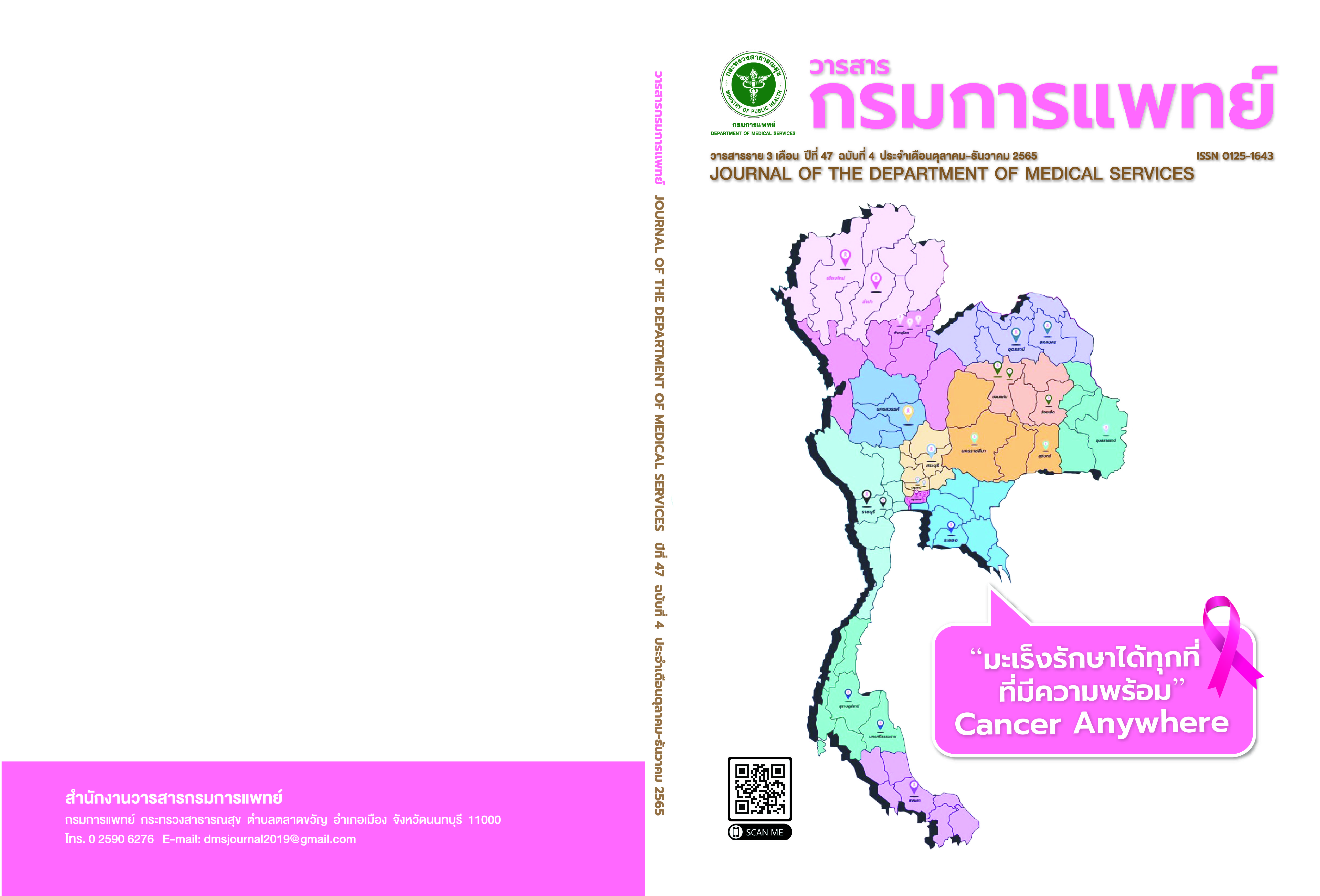Risk Factors of Low Neutrophils in Cancer Patients at Lop Buri Cancer Hospital
Keywords:
Neutrophil, febrile neutropenia, risk factors for neutropeniaAbstract
Background: Neutropenia is common after receiving chemotherapy and increases your risk for infections.Fever during neutropenia could be a very serious consequence. Objective: To study the risk factors of neutropeniaand to determine the incidence of febrile neutropenia in cancer patients at Lop Buri Cancer Hospital. Method: Thiswas a cross-sectional study reviewing the medical records of 307 people diagnosed with cancer and their identifiedstage. Data were collected from October 1, 2019, to September 30, 2020, using the data collection on the incidenceof neutrophil neutropenia in cancer patients. The relationship between factors was analyzed using the chi-squaretest and binary logistic regression analysis. Results: From the sample of 307 patients, it was found that the riskfactors associated with neutrophil neutropenia were statistically significant at the 0.05 significance level, which wasstage 2 disease (OR 0.18, p-value = 0.001), number of chemotherapy doses 2-6 (OR 2.51, p-value = 0.006), and initialneutrophil leukocyte levels that were lower than normal (OR 4.67, p-value < 0.001). Initial neutrophil leukocytelevels grade 1 (OR 3.41, p-value = 0.005) and grade 2 (OR 8.95, p-value = 0.001) were not significantly correlated.The following complications were fever (OR 5.33, p-value = 0.031). fatigue (OR 4.92, p-value = 0.011) and burning/urinating. Sparse (OR 16.13, p-value = 0.014) compared with those with normal neutrophil leukemia. Statisticallysignificant (p-value <0.001). Conclusions: Both patients with normal baseline neutrophil leukocyte levels and lowinitial neutrophil leukocyte levels could have a lower neutrophil level as well as low neutrophil leukocytosis afterundergoing treatment. Therefore, there should be treatment guidelines for every patient in order to prevent thedevelopment of low neutrophils or their recurrence, along with complications from neutropenia.
References
Chaiwong N. Development of nursing practice guidelines toprevent infection in cancer patients with Neutropenia afterchemotherapy treatment, ward 5 J . Srinagarind hospital. 2558;2-1
Teparat P, Kanitsap N. Potential risk factors of febrile neutropeniain cancer patientsreceiving chemotherapy. Thammasat Medical Journal .2015; 15(2): 200-209
Borisutbuathip D, Kongpanvijit O. Febrile Neutropenia in AcuteLeukemic Patients Receiving Chemotherapy at Faculty ofMedicine Vajira Hospital, Navamindradhiraj University . VajiraMedical Journal. 2014; 58 (3): 22-32.
Koinis F, Nintos G, Georgoulias V, Kotsakis A. Therapeuticstrategies for chemotherapy-induced neutropenia in patientswith solid tumor. Expert Opin. Pharmacother 2015; 16: 1505- 19.
Lekdamrongkul P. Nursing Management and Assessment ofFebrile Neutropenia (FN) Risks in Cancer Patients Treated withChemotherapy: The Role of Nurses. Thai Journal of NursingCouncil. 2015; 30 (1): 5-15.
Traiwaree C, Saiwaew A, Lamkun R, Torjarat K. Infection inchildhood oncologic patients with febrile neutropenia at thePhramongkutklao Hospital . Royal Thai Army Medical Journal .2012; 65: 211-18.
National Comprehensive Cancer Network. Clinical practiceguidelines in oncology (NCCN Guidelines) All Patients at Riskof Neutropenia Need Growth Factors [online].[cited August 20,2020] Availiable from: https://journals.lww.com/oncology-times/fulltext/2005/05100/ new_nccn _guidelines__all_patients_at_risk_of.24.asp
Lopburi Cancer Hospital. Statistics of Low Neutrophils in CancerPatients . 2019
Luepuech A, Danwilai K . Incidence and Risk Factors ofNeutropenia in Breast Cancer Patients Receiving IntravenousChemotherapy at King Chulalongkorn Memorial Hospital.ThaiJournal of Pharmacy Practice. 2017 ; 9 (1): 180-91
Lyman GH, Professor of Medicine, Division of Medical Oncology,and Director, Health Services and Outcomes Research, DukeUniversity. Management of Chemotherapy-induced Neutropeniawith Colony-stimulating Factors. Eur Oncol Haematol. 2008; 04(02): 13.
Schwenkglenks M, Pettengell R, Jackisch C, Paridaens, ConstenlaM, Bosly A, et al. Risk factors for chemotherapy-inducedneutropenia occurrence in breast cancer patients: data from theINC-EU prospective observational European neutropenia study.Support Care Center 2011; 19: 483-90
Earphaopun W, Ruchutrakool T, Harncharoen K, Siri S. EarlyFebrile Neutropenia in Acute Myeloid Leukemia PatientsReceiving Induction Remission Chemotherapy at Siriraj Hospital[dissertation]. Bangkok : Mahidol University ; 2014.
Freifeld A . Clinical practice patterns of managing low-risk adultfebrile neutropenia during cancer chemotherapy in the USA.Support Care Cancer. 2012; 16: 181- 91.
Braga CC, Taplitz RA, Flowers CR. Clinical Implications of FebrileNeutropenia Guidelines in the Cancer Patient Population. J OncolPract. 2019; 15 (1): 25-6.
Jason D. Wright et al. Deviations from Guideline-Based Therapyfor Febrile Neutropenia in Cancer Patients and Their Effect onOutcomes. JAMA Intern Med. 2013; 173 (7): 559-68.
Downloads
Published
How to Cite
Issue
Section
License
Copyright (c) 2022 Department of Medical Services, Ministry of Public Health

This work is licensed under a Creative Commons Attribution-NonCommercial-NoDerivatives 4.0 International License.
บทความที่ได้รับการตีพิมพ์เป็นลิขสิทธิ์ของกรมการแพทย์ กระทรวงสาธารณสุข
ข้อความและข้อคิดเห็นต่างๆ เป็นของผู้เขียนบทความ ไม่ใช่ความเห็นของกองบรรณาธิการหรือของวารสารกรมการแพทย์


